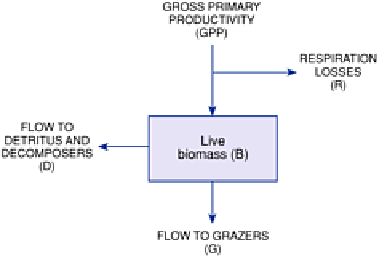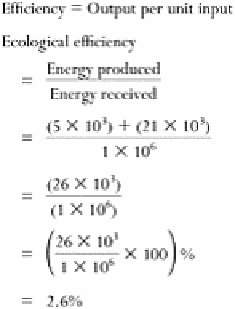Environmental Engineering Reference
In-Depth Information
(C) or are energy inputs. These values are also shown in Table 22.3, together with values
for biomass (kilojoules per square metre).
There are many reasons for studying energy flow in both natural and cultivated
ecosystems. One reason is that
Figure 22.3
Quantities measured in the calculation of net
primary productivity and net ecosystem production.
the
ecological efficiency
of different ecosystems can be compared. From the data for
Wytham Wood the efficiency of the trees and shrubs can be calculated as follows:
This low figure is characteristic of terrestrial ecosystems. Many authorities estimate that
about 2 per cent of the usable light energy is fixed by plants. As only about 50 per cent of
incident solar radiation is in the visible range of wavelengths absorbed by chlorophyll,
the efficiency of total radiation is only about 1 per cent. In water bodies much radiation is
absorbed by the water and its impurities, so efficiencies are much lower, probably in the
range 0·1-0·2 per cent on average.
In attempting to understand ecosystems, biogeogra-phers frequently subdivide
organisms into
trophic levels
, where trophic level is defined as 'the level at which an
organism feeds in food chains or food webs. It gives the level or stage at which food
energy passes from one organism to another.' In Wytham Wood insects, caterpillars,


